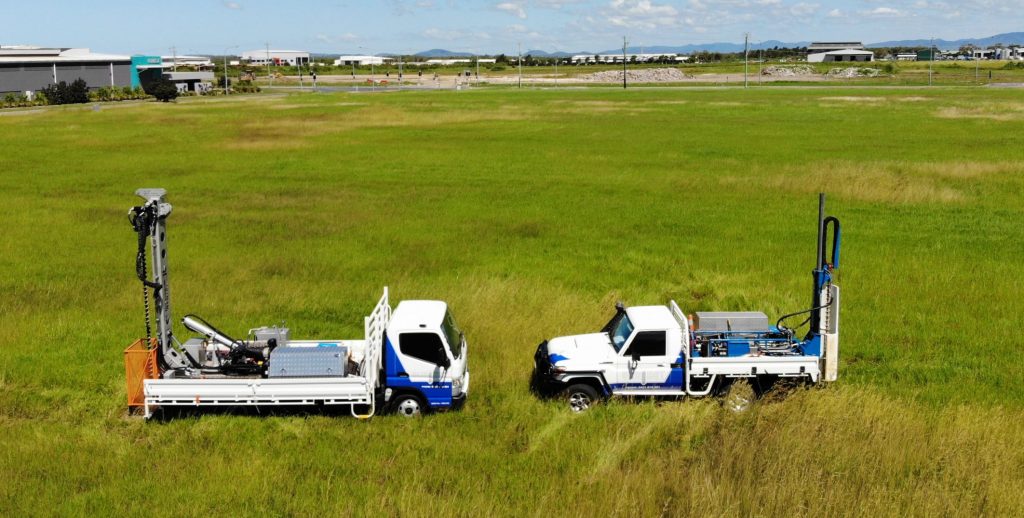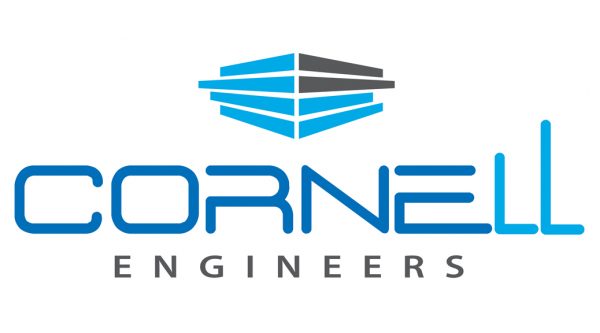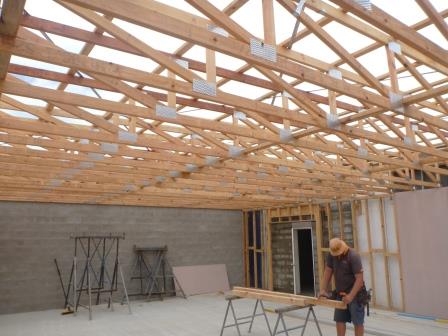Here’s a question about waffle slabs on Class H2 soil that we have been asked more than once:
“We have a soil test for our new house. It came back as Class H2. The builder we went to is planning on using a waffle slab. Will our house be ok?”
So let’s work out some of the terminologies first and then I’ll explain what my advice was and why.
What is Class H2 Soil?
In Australia, soil conditions for residential buildings are classified according to Australian standard AS2870. The latest version of this standard is the 2011 version.
The standard classifies soil mainly based on soil reactivity – how much the clay in the soil is likely to absorb and release moisture and how much the soil will swell and shrink. The swelling and shrinking of soils result in vertical movement of the soil surface. Uneven vertical movement can damage houses.

It comes down to this: a class H2 soil is a highly reactive clayey soil that between wettish and dryish soil moisture conditions can produce very high ground movement. In numbers: 60mm to 75mm of vertical movement.
When is house movement a problem?
Soil movement under a house only becomes a major problem when it is uneven. If a whole house lifts and drops at the same rate then there is unlikely to be evidence of this movement inside the house.
House damage results if part of a house moves up or down 60mm and part of the house does not move at all.
That is partly the purpose of AS2870: to provide footing (and slab) systems that can tolerate or resist uneven movement.
The tools the standard uses to protect houses against uneven movement are stiffer, stronger footings, deeper footings, isolation from ground movement and protection of soils from extremes in soil moisture conditions (very wet and very dry soils are specifically excluded from the scope of the standard).
Stronger, stiffer footing systems can span further over areas of uneven ground. The house might still move, but the strength of the footing system is there to moderate the movement.
Waffle Slabs and Ground Movement
Waffle slabs use a grid of concrete beams under the slab to achieve the required strength and stiffness to counter ground movement. Deeper concrete beams mean more strength and more stiffness.
Again, the higher the soil reactivity the stronger and stiffer the footing and slab system needs to be.
Can I Use a Waffle Slab on a Class H2 Soil?
AS2870 says waffle slabs can be used on reactive clay soils – even Class H2 soils – with some construction style limits:
- Timber frame: Yes.
- Articulated Brick Veneer: Yes
- Brick Veneer (without articulation): No
- Double Brick: No
Note that these rules can be overridden by a qualified and experienced structural engineer – but that is a whole different post.
Some Precautions to Take
These precautions apply to all reactive clay sites but they are much more important for highly reactive clay sites like Class H2 sites. They are even MORE important for waffle slabs:
- Plan your site works to ensure good drainage away from the building on all sides (even the upslope side).
- Manage stormwater drainage on the site from the very first day of the build. Do not allow water to pond near the footings.
- The bottom of the sewer and stormwater trenches outside the building must fall away from the building.
- Keep trees at least 2 x mature height away from the building.
- Build ponds and water features away from the house.
- Set up irrigation systems so they do not water close to the footings. Do not position sprinkler control boxes near the footings.
- Do not position garden beds near the house.
- Ensure paths and walkways fall away from the building. Position paths so that they do not dam water against the footings. The ground under pathways should also fall away from the building.
- Manage site stormwater with surface drains (spoon drains) that are away from the building in preference to underground pipes – particularly if there are large trees and lots of leaf litter.
- Do not discharge stormwater pipes onto the ground next to the building. Discharge to the gutter where possible or to bubblers positioned well away from the building in rural areas.
- Seal the gap between concrete pathways and ground slabs with flexible joint sealant (not just Abelflex).
- Builders fill used to raise the ground surface around waffle slabs should NOT be sandy soils. Clayey soils are better able to shed water away from the building.
- Position agricultural drains at least 1.5m away from the building.
What About Waffle Slabs on Screw Piers?
Here’s the thing. Waffle slabs sit on top of the soil and so when the soil is highly reactive, the waffle slab has to be designed for that ground reactivity.
The purpose of screw piers used with waffle slabs on reactive sites is to try and support the waffle slab at a depth where the ground moves less. The theory is if the waffle slab is supported where there is less movement the waffle slab can be designed for less movement. Right?
Wrong.
If a waffle slab is supported on screw piers and the house is constructed when the ground profile (full depth of soil) is dry, when the amount of moisture in the soil increases (ie when it rains or when you, the homeowner, start watering your Sir Walter turf), the ground surface lifts.
The Class H2 ground surface pushes on the underside of the waffle slab and the waffle slab lifts. Well, it tries to.
If the screw pier is designed for that lifting force from the ground pushing up on the waffle, and the screw pier doesn’t dislodge from the underside of the waffle slab and the screw pier connectors don’t come undone and the blades of the waffle screw pier don’t lift up in the ground (wow) then the force of the ground pushing on the underside of the waffle pod slab becomes enormous. So hopefully your engineer designed the waffle slab for all of these forces and your waffle slab is really, really heavily reinforced. You’ll know if it is because your concretor will complain about all the steel in the waffle slab.
But if it isn’t or one of those other connectors isn’t tight or the waffle slab is embedded into the waffle slab with a slip joint like one of these:
Looking for More Information?
Check out these guides for more information:


13 replies on “Waffle Slabs on H2 Class Soil”
Great article.
We are going through a knock down and rebuild on H2 soil. We just knocked down our existing home and discovered deep concrete pillars. I believe our builder is planning a waffle slab / brick veneer / metal framing. Is this an issue? Thanks.
Hi
My question is
Can you work out what kind of site classification the site might come out from an engineered fill plan of new sub division?
Hi Kishor
Umm. No. Well yes because most soil testers will still call the site a Class P site and you’ll need an engineer to design your footings. But no because the nature of the fill won’t be exactly as specified, won’t be compacted exactly as specified and the site classification is maybe still reliant on the natural soils at the bottom of the fill (depending on the depth of fill and the Hs for your site).
Matt Cornell
Hi, Our land is H2 soil and some serious pillars have been put in place to support our slab. My question is more about whether I need to use pillars to support a 5m X 5m slab for our back yard pergola? If so, and I suspect we will, can I get some advice on how many, and the depth and diameter of the pillars? We will be tiling on top of the slab, so want minimal (none) cracking down the track. Cheers
I have a question, if soil bearing capacity 100kpa is at 1500mm depth then we have to provide the bored pier for waffle slab, my question is that how to arrange pier under waffle slab? Is there any formula or any distribution method?
Hi Sumit
That question should be referred to the experienced engineer in your firm that is mentoring and coaching you.
Best Regards
Matt Cornell RPEQ 6598
Hi
Can you please share your expertise .
I have brought a land recently and soil test came as Site classification P soil and Soil classification as H1 type In my contract I am covered for class M slab engineered beam at 200 mm at no extra cost .Now can you please tell me for the site soil type what sort of slab will be suitable and how much extra cost will be Incurred .your help will be much appreciated .
Thank you
Dear Raj
It will depend on your engineer and the details contained within your soil test. Many sites are classified as Class “P” as a warning to the design engineer to take note of the particular site characteristics present. Unfortunately there are too many variables for us to comment however take the time to allow your builder to explain the cost variation to you and don’t be afraid to ask the builder or the engineer for more information if you don’t understand. It’s your money and it’s your house – you need to be comfortable with your investment.
Best of luck.
Matt Cornell – Cornell Engineers
I have an E site that has been purchased the engineer says that everything’s OK, how can this be? It’s an E soil thats even worse than H.
To Whom It May Concern,
I’m in the very early stages of building a house (tender stage). Our Soil Report has come back as a “H1″ with the following comments:-
“Due to depth and type of fill, provide “H1” type raft founded onto firm existing controlled fill material”. Later on in the report it also states that Footing Piers & Slab Piers are not required.
When I’ve reviewed my quotation, it states “reinforced concrete slab for soil classification type H1 with an additional cost. A lot of your posts have indicated that this shouldn’t be at an additional cost.
2 questions – (1) should it be more expensive ? (2) do you believe this poses a greater risk and how would this be covered by a builders structural warrant, should something go wrong?
Thanks very much for your time/advice.
Hi, I’m a bit confused.
Our Soil test report says that the site is classified as “class P” due to proximity of trees and their potential to cause Abnormal Moisture Condition onsite, and the underlying soils are classified as class “M-D” type soil. The engineers have recommended for a class H2 Waffle slab.
Is this the right slab to use? Will we be expecting some damages/ cracks in the future?
Thanks for your help. Greatly appreciated.
Hi Ike
Trees increase the difference between wet and dry soil conditions by removing moisture from the soil in dry times and by having little effect in wet seasons. The larger range in soil moisture conditions increases the potential amount of soil movement under your house. So trees cause there to be more ground movement than your soil tester and engineer normally design your house footings for.
Whether the increase from Class “M-D” to Class “H2” is sufficient or overkill is an assessment that your engineer must make after taking into account the soil conditions, the number of trees, how close they are to the building, how tall they are (or could become) and a number of other factors.
Note that even well designed homes move and crack. A correct footing design will try to moderate movement to within tolerable limits that fragile linings like brickwork and plasterboard can handle. But you’ll have a part to play too – most importantly by maintaining good drainage around your home and by not overwatering your lawn.
The good news is that 1) you have an engineer designing your footings; 2) the engineer knows enough to consider the drying effect of trees; and 3) you’re considering these things now, before your house is built.
All the best with your new house. Enjoy the build process and definitely enjoy your new home.
Matt
I liked that you specified the construction styles that I can use when building a waffle slab on Class H2 soil. I’ve been considering using brick veneer for a waffle slab on my property before reading this post. Now that I know what my limitations are, I should consider using a timber frame or articulated brick veneer since they’ll work better on Class H2 soil.